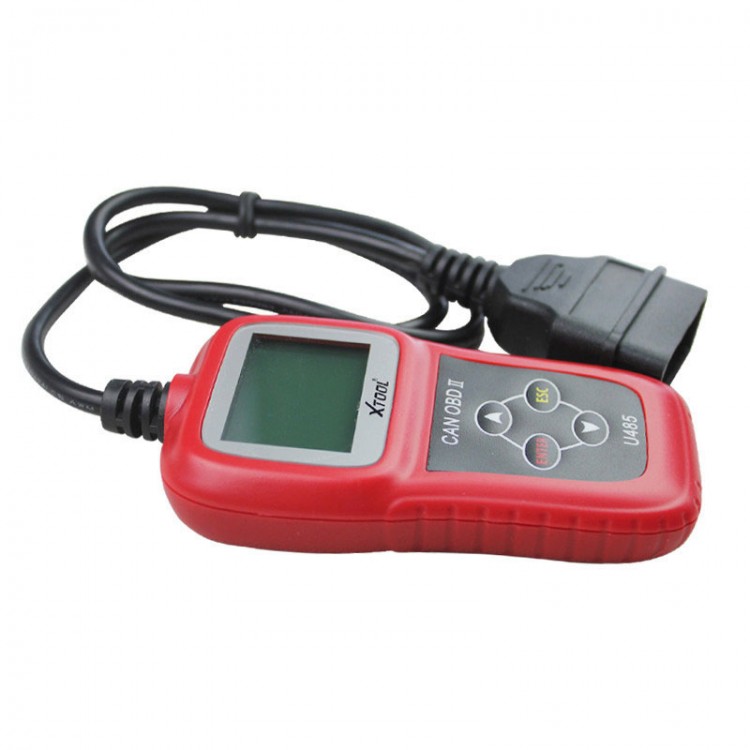
| Quantity | 3+ units | 10+ units | 30+ units | 50+ units | More |
|---|---|---|---|---|---|
| Price /Unit | $29.39 | $28.79 | $27.89 | $26.69 | Contact US |
 USBCAN-OBD Portable Automotive Decoding Single Channel USB CAN Analyzer Dedicated for Automotive OBDII
$41.13
USBCAN-OBD Portable Automotive Decoding Single Channel USB CAN Analyzer Dedicated for Automotive OBDII
$41.13
 AERMOTOR EM415PRO 6-42V Car Short Open Circuit Detector Automotive Circuit Tester without Oxford Bag
$15.41
AERMOTOR EM415PRO 6-42V Car Short Open Circuit Detector Automotive Circuit Tester without Oxford Bag
$15.41
 MAYILON MY6770 Automotive Coating Thickness Gauge Paint Thickness Gauge Fe/NFe 0-1300µm Tester
$39.11
MAYILON MY6770 Automotive Coating Thickness Gauge Paint Thickness Gauge Fe/NFe 0-1300µm Tester
$39.11
U485 EOBD2 OBD2 CAN BUS Diagnostic Scanner Live Data Reset Clear Check Engine Light
Tool Description
- LCD Display , 128*64 pixel display with contrast adjustment, Backlit
- Enter key selects displayed
- Exit key go back to the previous screens
- Up/down arrows-moves the selection pointer and scrolls up or down.
- LEFT/RIGHT arrows-Select responses and moves cursor.
- OBDII connector cable, connect car and the scan tool
- This auto scanner (OBD II car reader) easily connects to the diagnostic socket and will quickly find your trouble issues by reading the specific diagnostic trouble codes (DTC) and shows their description as well. Moreover, this tool can display live data from your car's computer, such as current RPM, engine coolant temperature, vehicle speed, oxygen sensor data, and much more.
This reader works on the following protocols:
- SAE J1850 - PWM
- SAE J1850 - VPW
- ISO 9141-2
- ISO 14230-4 - KWP 2000
- ISO 15765-4 / SAE J2480
- Controller Area Network (CAN)
Product Specifications
- Display-Backlit LCD, 128*64 pixel display.
- Operating Temperature- 0 to 50
- External Power: 10.0 to 15.5 vols provided via vehicle battery
Product Features:
- Works on all 1996 and newer cars & light trucks that are OBD II compliant (including the VPW, PWM, ISO, KWP 2000 and CAN protocols)
- Reads and clears generic and manufacturer specific Diagnostic Trouble Codes (DTCs)
- Turns off check engine light
- Trouble codes display on the LCD, needn't the code book. Switch between Metric and English Units!
- Scanning live data
- Reading Freeze Frame Data
- Testing I/M Reading Status
- Reads vehicle information including VIN (if your vehicle is able to provide that)
- Rescans Data
- Easy to use with one plug-in.
- Highly reliable and accurate
- Easy-to-read crystal-clear LCD display
- Stand-alone unit with no need for an additional laptop computer to operate
- Performs continuous DTC scan
- Safely communicates with the on-board computer
Does My Car Have OBD-II?
All cars and light trucks built and sold in the United States after January 1, 1996 were required to be OBD II equipped. In general, this means all 1996 model year cars and light trucks are compliant, even if built in late 1995.
Two factors will show if your vehicle is definitely OBD II equipped:
- There will be an OBD II connector located under or around the dashboard, and
- There will be a note on a sticker or nameplate under the hood: "OBD II compliant".
Where is the connector located?
The connector must be located within three feet of the driver and must not require any tools to be revealed. Look under the dash and behind ashtrays.
The Three Flavors of OBD II
- While the parameters, or readings, required by OBD II regulations are uniform, the auto manufacturers had some latitude in the communications protocol they used to transmit those readings to scanners. Naturally, each felt they had the one true way, so we have three different OBD II communications protocols in use.
What Communications Protocol does my vehicle use?
- As a rule of thumb, GM cars and light trucks use SAE J1850 VPW (Variable Pulse Width Modulation). Chrysler products and all European and most Asian imports use ISO 9141 circuitry. Fords use SAE J1850 PWM (Pulse Width Modulation) communication patterns.
- There are some variations among captive imports such as the Cadillac Catera, a German Opel derivative, which uses the European ISO 9141 protocol.
- On 1996 and later vehicles, you can tell which protocol is used by examining the OBD II connector:
- J1850 VPW - The connector should have metallic contacts in pins 2, 4, 5, and 16, but not 10.
- ISO 9141-2 - The connector should have metallic contacts in pins 4, 5, 7, 15, and 16.
- J1850 PWM - The connector should have metallic contacts in pins 2, 4, 5, 10, and 16.
The following is a reduced list of tested vehicles:
- Acura, Aston Martin, Audi, Bentley, BMW, Buick, Cadillac, Chevrolet, Chrysler, Daewoo, Dodge, Eagle, Ferrari, Fiat, Ford, GMC, Honda, Hummer, Hyundai,
- Infiniti, Isuzu, Jaguar, Jeep, Kia, Land Rover, Lexus, Lincoln, Maserati, Mazda, Mercedes, Mercury, Mini, Mitsubishi, Nissan, Oldsmobile, Opel, Peugeot, Pontiac, - Porsche, Renault, Saab, Saturn, Scion, Smart, Skoda, Subaru, Suzuki, Toyota, Volkswagen, Volvo,etc.
Note: This scanner is not compatible with Class 3 and larger Diesel Trucks.
PACKAGE CONTENT:
- U485 Professional CAN OBD II Auto Scanner Tool
- Instruction Manual